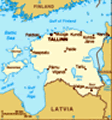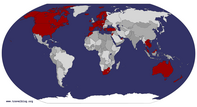Advertisement
Published: August 11th 2007
Welcome to the Eastern Bloc
Estonia, where is Estonia? I’m sure the question has passed through many lips since hearing or seeing that we were taking a brief stop in Tallinn, the capital of the ex-Eastern Bloc country. While not a country or city that is commonly on anyone’s mind in America, this convenient port city has become one of the more common stops for Baltic cruises. It seems anyone heading to St. Petersburg or Helsinki on one of those behemoth cruise ships has stopped here for at least an hour or two.
“So what’s the deal with Estonia?” you ask. This country has been through some serious hard times in the last hundred years and has belonged to some other country for much of the last 800 years. I’m sure that many of the small European countries have fallen into other’s hands due to colonialism or empiric expansion but, for us, it seems that Estonia is one of the major European underdogs in the word of nationalism.
In the 1200s the Danes attacked Estonia and very quickly annexed Estonia into, what was then, a huge Danish Empire consisting of most of Scandinavia. A few hundred
years later the Swedes took over from the Danes only to lose the country to the Russians. During the 1700s the Russians were quite cruel to the Estonians but eventually the Estonians held strong and gained their independence right around the turn of the 20th century.
During the first third of the 1900s the Estonians prospered and caught up with much of Europe on technology and quality of life. Many industries, including the radio industry, thrived in Estonia promising a bright future for this small Baltic state. Then the worst happened. In 1940, during the rise of the German/Nazi expansion through Europe, the Russians decided to move closer to the fighting and consolidate the region. Thus the Russians took over Estonia, as well as Latvia and Lithuania, in order to increase their military and naval bases on the Baltic. During this brief period of time (1940-1941), the Russians treated the Estonians like poo. People were pushed into extreme production goals, food was shipped from Estonia, into Russia. People who disagreed with policies were killed. It’s your basic Soviet scenario of double standards, propaganda and oppression.
In 1941 the Germans came strolling through the area on their way to
Russia. The Estonians were treated poorly by the Germans, but may have actually been treated better by the Nazis than they were by the Soviets. The population was so concerned about the Russians return (they didn’t want it!) that many Estonians actually volunteered to help the Nazis defend their conquered lands. As we all know, the Estonian volunteers may have helped but ultimately the Allies, including the Soviets, beat back the Germans and were finally victorious.
Much to the dismay of the Estonians, part of the agreement between the Allies was that borders would return to their state as of 1941. This meant that Russia still had control over Estonia and other countries that they had forced themselves into. Subsequently the Estonians remained part of the Soviet Union until they were granted independence in 1991. During the close to fifty years that Estonia was part of the USSR, their country was turned upside down in the name of Communism. People were murdered, almost 20 thousand who were accused of supporting the Nazis were kidnapped and forced into labor camps or killed, and almost the whole population lived in a state of rationing, hoarding and nearly constant fear. This fear
is so ingrained that many people who grew up during this era still are afraid to talk about it today.
I can already hear the next question coming out of your mouths, “Why would you want to come to a place like this?” It’s simple, these people have done a masterful job of bouncing back from the oppression of the Soviets. They have turned their country around, are almost all very friendly and the sights here are worth seeing.
We spent our two days here completely in the Old Town area. This area is one of the best preserved Nordic Old Towns in the world. While many buildings have been destroyed due to the various wars, the government has done a decent job of putting things back together. Thus, you have a decent sized quarter that looks mostly medieval surrounded by Soviet era concrete monstrosities that are mostly falling apart. Interesting contrast, no?
Our first full day here we continued to have really good weather. It rained a bit in the late morning but otherwise it was sunny and mild all day. We took advantage of the great weather by walking around town, exploring what the old
town had to offer. When its sunny, take advantage of the weather.
When it started raining around lunch time we decided to head to an area of town, up towards the top of the Old Town hill, where we had seen a ton of amber jewelry shops. Amber is huge in this part of the world mostly because this is where the vast majority of it comes from. It often washes up on the beach but in some cases it is actually mined. While it is not a precious stone it is pretty rare and can be quite expensive. Since the exchange rate is much better here than anywhere else in Scandinavia and because there seemed to be so much competition for tourist dollars, we figured we’d check out the jewelry and see what we could find.
After touring about five shops we settled on a piece that Kel had seen in the very first shop we entered. We managed to get Kel a pendant and matching earrings for at least 25% less than we would have paid in the states. It often pays to bargain hunt when traveling.
With jewelry shopping done we headed back down
to the main town square. We lucked out as we walked back to town, the weather had turned for the better and the sun was out in all its glory. We decided to settle in a café on the main square a get a beer. As an added bonus, during our two day stay in Tallinn, the Baltic Folklore Festival was being held on a decent sized stage right in the main town square. We proceeded to spend the next two hours swilling beer and enjoying the dances and songs that were going on right in front of us. People from all over the region had come in native costume to perform their traditions for us. Some of the costumes were amazingly intricate with bright scares, huge necklaces and neat hats. It was a ton of fun to watch.
We managed to sit right next to a couple of business travelers from the US who were taking a weekend break from work. We really lucked out in this case because both of them had traveled extensively through Eastern Europe because of business. They were able to give us some good advice and confirm our feelings about a few of
the places that we had thought about visiting.
History and Relaxation Our final day in Estonia turned out to be yet another beautiful day. I’m sure we will pay for this beautiful weather with a bout of foul weather some place else, but we certainly enjoyed the beauty while we could. After a mid-morning breakfast we headed out into the sunny but cool weather in order to hit the last few sights we wanted to see.
Our major stop for the day was the Estonian Museum of Occupation. Much of what you read above was learned at this small but incredibly informative museum. Funded by an Estonian/American, the Occupation Museum was built in the last few years. It houses a decent collection of stuff from different eras of Soviet and Nazi occupation.
The really interesting parts of the museum are the videos. The long 50 year occupation period is broken up into smaller block of close to ten years. Each of these periods has a video associated with it that contains interviews, archival footage of propaganda and interesting historical anecdotes on the period of time. While a little too long (each movie was right
around 30 minutes long), these movies really gave one a much better understanding of the desperate situation that people were in during this country’s occupation, specifically during the Soviet occupation. It is almost impossible for me to convey what I felt while hearing about how difficult and, as an American, unfair life was for these poor people. I can only imagine how horrible it must have been to live through these years, specially the period from 1940-1960 when it seems that the exploitation and terror were the worst. Just amazing what these people have had to survive.
From the Occupation Museum, it was a quick one block walk to the Kiek in de Kök (makes me giggle a bit every time I say it) museum in a nearby outer tower of the Old Town wall. We were hoping for another informative and interesting museum but found this one to be dull and not really worth our while. It gave some history of the town and showed some of the weapons used to defend the city. If you’re heading in this direction, I would skip this one.
We got some lunch after walking around the town a bit and
decided to spend the rest of our afternoon resting in the hotel pool area. While the pool was inside, it was nice to swim a bit and relax instead of running around town like we usually do. Sometimes it’s nice to be lazy! It is Saturday, so I guess we should relax like we would if we were home!
Well, hope everyone is happy back home. We miss you all!
Advertisement
Tot: 0.061s; Tpl: 0.012s; cc: 9; qc: 29; dbt: 0.0291s; 1; m:domysql w:travelblog (10.17.0.13); sld: 1;
; mem: 1.1mb























